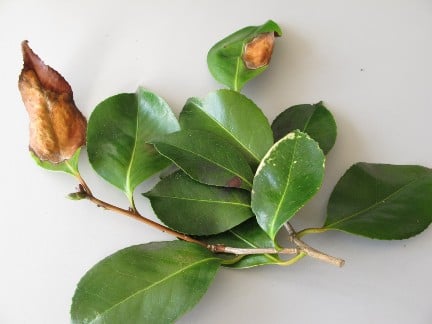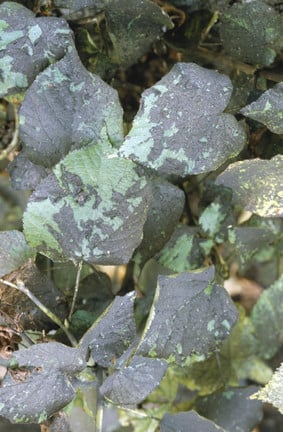
Quick facts
Common name - Camellia leaf blight
Scientific name - Monochaetia karstenii and Pestalotiopsis species
Plants affected - Camellia spp.
Main symptoms - Brown leaf blotches, premature leaf loss and twig or branch dieback
Caused by - Fungi
Timing - Following prolonged wet periods throughout the year
What is camellia leaf blight?
Camellia leaf blight is a disease that can be caused by two fungal pathogens: Monochaetia karstenii or Pestalotiopsis species. The development of the disease is favoured by wetness on the leaves and any factors that weaken or damage the foliage.
Symptoms
You may see the following symptoms:
- Discoloured patches develop on the leaves. These soon turn brown, giving the lesions a scorched appearance
- Numerous tiny, black fruiting bodies of the causal fungus develop over the surface of the lesion (damaged area). In wet or very humid conditions these may be seen to exude a black tendril of spores
- Infected leaves often fall prematurely. The infection can spread down the and into the branch, leading to dieback. Affected may decay completely
N.B. Camellia leaves may also develop brown patches as a result of frost damage in spring, or sun scorch during hot summers. In these cases the symptoms will often develop quite rapidly on several leaves at the same time, and fungal fruiting bodies won't be visible. See our advice profile on camellia problems for further details and photos.

Control
The RHS believes that avoiding pests, diseases and weeds by good practice in cultivation methods, selection, and encouraging or introducing natural enemies, should be the first line of control. If chemical controls are used, they should be used only in a minimal and highly targeted manner.
Non-chemical control
- Good hygiene can help, as do cultural control measures. These include removing affected leaves, twigs or promptly and destroying them. Where possible, keep leaves dry to prevent dispersal and of the spores
- If pruning out affected twigs or branches, disinfect the pruning implement between each cut
Fungicides
The RHS recommends that you don't use fungicides. Fungicides (including organic types) may reduce , impact soil health and have wider adverse environmental effects. If you do intend to use a fungicide, please read the information given in the link and download below to ensure that use, storage and disposal of the product is done in a responsible and legally compliant manner.
The products listed in the ‘Fungicides for gardeners’ document below are legally available for use by home gardeners in the UK. This information is provided to avoid misuse of legal products and the use of unauthorised and untested products, which potentially has more serious consequences for the environment and wildlife than when products are used legally. Homemade products are not recommended as they are unregulated and usually untested.
There is no information available on the efficacy of any home garden fungicide against camellia leaf blight.
Download
Fungicides for gardeners (Adobe Acrobat pdf document outlining fungicides available to gardeners)
Link
Biology
Large numbers of spores are produced by the fruiting bodies. The spores are spread by water splash, and will germinate to create new infections if the leaf surfaces stay wet.
The fungi are generally regarded as weak pathogens, and are much more likely to colonise plant tissue that is damaged, dead or that has been weakened by stress factors.






